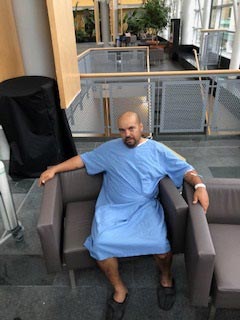It was about 5 a.m. in early October and Emanuel Samanica was driving home from visiting his girlfriend in Ohio when the chest pain began. It intensified and became coupled with difficulty breathing, so upon arrival in Toronto he called a family member and was driven to Humber River Hospital (HRH).
A collection of tests, including a chest X-ray and an electrocardiogram, revealed nothing. Despite being sent home with painkillers and a high dose of anti-inflammatory medication, Emanuel was soon back at HRH – this time via ambulance – where a CT scan revealed a life-threatening condition: his aorta, the largest artery that carries blood from the heart to other parts of the body, was dissected, or split.
 Emanuel was immediately transferred to Peter Munk Cardiac Centre (PMCC), where a surgical team led by Drs. Maral Ouzounian and Jennifer Chung spent nine hours repairing his aorta and preserving his aortic valve.
Emanuel was immediately transferred to Peter Munk Cardiac Centre (PMCC), where a surgical team led by Drs. Maral Ouzounian and Jennifer Chung spent nine hours repairing his aorta and preserving his aortic valve.
But Emanuel, who is now on the road to recovery, is one of the lucky ones.
Aortic dissections can be deadly, and are often misdiagnosed as a heart attack, or a stroke. Typical symptoms include sudden and severe chest pain, dizziness, vomiting and difficulty walking and speaking.
Not only can they be silent and deadly, but no one knows what causes them.
Drs. Ouzounian and Chung, surgeon-scientists at PMCC, are on a mission to solve this mystery.
February is Heart Month, a time to bring attention to the importance of cardiovascular health, and what we can do to reduce our risk of cardiovascular disease.
The skilled minds and hands of Drs. Ouzounian and Chung, and quick action, applied an advanced surgical technique to save Emanuel. Developed at Toronto General Hospital (TG) by renowned cardiovascular surgeon, Dr. Tirone David, it allows the patient's aortic value to be preserved and reconnected to a synthetic graft.
The technique means patients can avoid taking blood-thinning medications for the rest of their lives.
This procedure was not possible for everyone, but it was possible for Emanuel, who was able to go home after spending some time recovering in hospital, first in the intensive care unit, and then on TG's cardiac floor.
 Emanuel's recovery continues smoothly, with a couple of limitations: he can't walk for long periods of time, and the 40-year-old delivery person will not be able to lift large objects or do strenuous physical activity for at least six months. This is to protect his breastbone, which was opened for the surgery.
Emanuel's recovery continues smoothly, with a couple of limitations: he can't walk for long periods of time, and the 40-year-old delivery person will not be able to lift large objects or do strenuous physical activity for at least six months. This is to protect his breastbone, which was opened for the surgery.
But his doctors are confident he will make a full recovery.
Having had no discernible heart issues previously, Emanuel dug into his family history: Dr. Ouzounian had replaced the aorta of Emanuel's mother a year ago.
"Our take-home to all patients is that family members of those with thoracic aortic aneurysms should consider screening," says Dr. Chung. "Elective repair is much safer than emergency repairs."
Now, Emanuel is left with lots of knowledge — and two chest incisions, one under his right shoulder, and the other down the middle of his chest — that serve as a reminder of his life-altering experience.
His brothers will also be screened by Dr. Chung due to their mother and brother's experience.
Learning about this deadly condition has helped motivate him to further shed some light so that others can take appropriate action, should they face similar symptoms.
"I didn't know what [an aortic dissection was], until it happened to me," he says.
